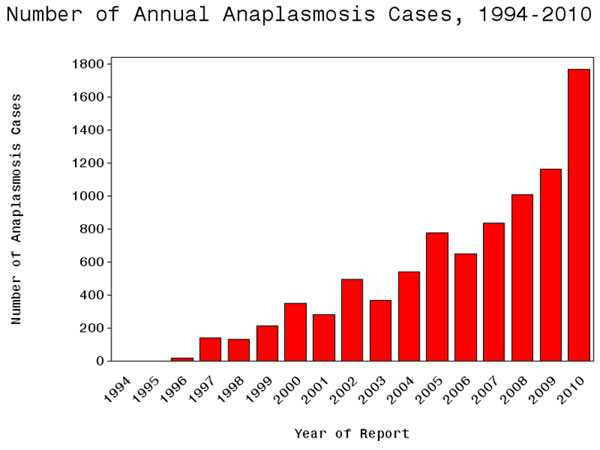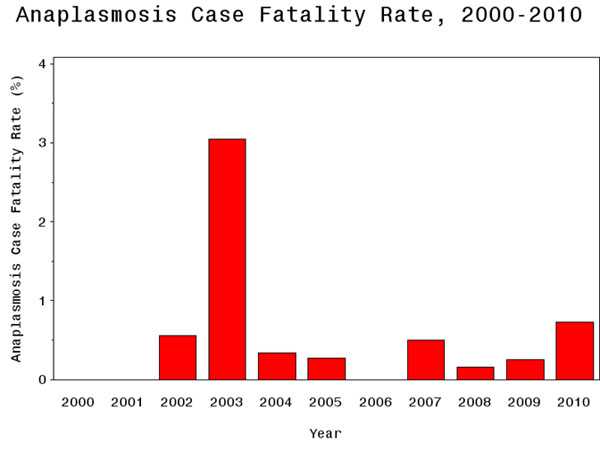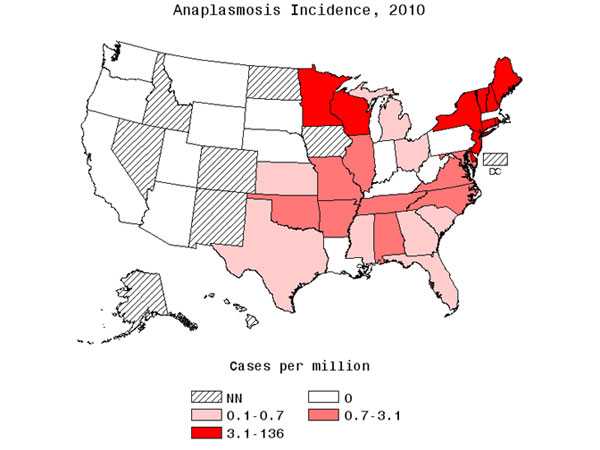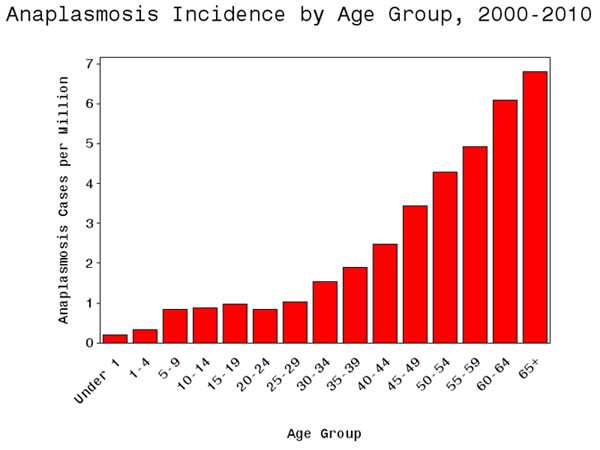Statistics and Epidemiology
Annual Cases of Anaplasmosis in the United States
Anaplasmosis was first recognized as a disease of humans in the United States in the mid-1990’s, but did not become a reportable disease until 1999. CDC compiles the number of cases reported by state health departments.
Anaplasmosis is caused by the bacterium Anaplasma phagocytophilum. This organism used to be known by other names, including Ehrlichia equi and Ehrlichia phagocytophilum, and the disease caused by this organism has been previously described as human granulocytic ehrlichiosis (HGE). However, a taxonomic change in 2001 identified that this organism belonged to the genus Anaplasma, and resulted in a change in the name of the disease to anaplasmosis.
The number of anaplasmosis cases reported to CDC has increased steadily since the disease became reportable, from 348 cases in 2000, to 1761 cases in 2010. The incidence (the number of cases for every million persons) of anaplasmosis has also increased, from 1.4 cases per million persons in 2000 to 6.1 cases per million persons in 2010. The case fatality rate (i.e. the proportion of anaplasmosis patients that reportedly died as a result of infection) has remained low, at less than 1%.
Figure 1 – Number of U.S. anaplasmosis cases* reported to CDC, 1994-2010.
*Numbers presented here may differ from numbers presented in the MMWR Annual Summary of Notifiable Diseases. Data presented here are based on year of illness onset rather than reporting year.

Number of annual anaplasmosis cases 1994-2010:
The graph displays the number of human cases of anaplasmosis cases reported to CDC annually from 1994 through 2010. Cases of anaplasmosis have generally increased from 350 cases in 2000, when the disease became nationally notifiable, to 1163 cases in 2009. The number of reported cases increased 52% between 2009 and 2010.
Figure 2 Proportion of U.S. anaplasmosis cases reported to CDC with fatal outcome (case fatality rate), 2000—2010.

Anaplasmosis case fatality rate 2000 through 2010:
This figure shows the proportion of fatal outcomes reported annually to CDC from 2000 through 2010. There were no fatalities reported in 2000, 2001 or 2006. Highest proportions of fatal cases were reported in 2003 during which time more than 3% of cases resulted in fatality. In all other years case fatality rates hovered around 0.5%.
| Year | Fatality rate |
|---|---|
| 2000 | No fatal cases reported |
| 2001 | No fatal cases reported |
| 2002 | 0.6% case fatality |
| 2003 | 3.0% case fatality |
| 2004 | 0.3% case fatality |
| 2005 | 0.3% case fatality |
| 2006 | No fatal cases reported |
| 2007 | 0.5% case fatality |
| 2008 | 0.2% case fatality |
| 2009 | 0.3% case fatality |
| 2010 | 0.7% case fatality |
Geography
Anaplasmosis is most frequently reported from the upper midwestern and northeastern United States. The areas from which cases are reported correspond with the known geographic distribution of Lyme disease. The tick responsible for transmission of A. phagocytophilum in the upper Midwest and northeastern U.S. is the black-legged tick (Ixodes scapularis). Along the West Coast, the western black-legged tick (I. pacificus) may transmit the organism. These tick species also transmit the agents of Lyme disease (Borrelia burgdorferi) and babesiosis (Babesia species), and human co-infections with these organisms have occasionally been reported.
Six states (New York, Connecticut, New Jersey, Rhode Island, Minnesota, and Wisconsin) account for 90% of all reported cases of anaplasmosis. Occasionally, A. phagocytophilum infections may be reported in other parts of the United States, including southeastern and south-central states where the organism is not commonly found. Some of these cases may be due to patient travel to states with higher levels of disease, or the misdiagnosis of anaplasmosis in patients actually infected with another tickborne disease, such as ehrlichiosis or Rocky Mountain Spotted Fever.
Figure 3 – Annual reported incidence (per million population) for anaplasmosis in the United States for 2010. (NN= Not notifiable)

Geographic distribution of anaplasmosis incidence in 2010:
This figure shows the incidence of anaplasmosis cases by state in 2010 per million persons. Anaplasmosis was not notifiable in Alaska, Colorado, the District of Columbia, Hawaii, Idaho, Iowa, Nevada, New Mexico or North Dakota in 2010. The incidence rate was zero for Arizona, California, Connecticut, Indiana, Kentucky, Louisiana, Massachusetts, Montana, Nebraska, Oregon, Pennsylvania, South Dakota, Utah, Washington, West Virginia and Wyoming. Incidence ranged between 0.1 to 0.7 cases per million persons for Florida, Georgia, Kansas, Michigan, Mississippi, Ohio, South Carolina, and Texas. Annual incidence ranged from 0.7 to 3.1 cases per million persons in Alabama, Arkansas, Illinois, Maryland, Missouri, North Carolina, Oklahoma, Tennessee, and Virginia. The highest incidence rates, ranging from 3.1 to 136 cases per million persons were found in Delaware, Maine, Minnesota, New Hampshire, New Jersey, New York, Rhode Island, Vermont and Wisconsin.
Seasonality
Although cases of anaplasmosis can occur during any month of the year, the majority of cases reported to the CDC have an illness onset during the summer months and a peak in cases typically occurs in the months of June and July. This period is the season for increased numbers of nymphal black-legged ticks, which is the primary life stage of this tick that bites humans and may transmit the pathogen.
Figure 4 – Proportion of anaplasmosis cases reported to CDC by month of onset, 2010.

Percent of anaplasmosis cases reported in each month:
This figure shows the percent of cases reported from 1994 through 2010 by month of onset to give the seasonality of cases. There are cases reported in each month of the year, however most are reported in June and July, with more than 25% of cases are reported in June.
Persons at Risk
The frequency of reported cases of anaplasmosis is highest among males and people over 40 years of age. A compromised immune system (such as may occur through cancer treatments, advanced human immunodeficiency virus infection, prior organ transplants, or some medications) may increase the risk of severe outcome. Individuals who reside near or spend time in known tick habitats may be at increased risk for infection.
Figure 5 – Average annual incidence of anaplasmosis by age group, 2010

Anaplasmosis incidence by age group:
This figure shows the average annual incidence of anaplasmosis per million persons by age groups for 2000 through 2010. The graph shows that cases have been reported in every age group with increased incidence as age increases. The highest rate of incidence, more than 6 cases per million persons, is seen in persons 65 and older.
Other Ehrlichiosis, Undetermined
This reporting category reflects cases that showed clinical and laboratory signs consistent with either an ehrlichiosis or anaplasmosis infection, but which could not be attributed to a specific organism due to the limitations of diagnostic test results. This category is also used to report new cases of human illness attributed to other Ehrlichia or Anaplasma species.
Further Reading
- Dahlgren FS, Mandel EJ, Krebs JW, Massung RF, McQuiston JH. Increasing incidence of Ehrlichia chaffeensis and Anaplasma phagocytophilum in the United States, 2000–2007. Am J Trop Med Hyg(85)2011,124
- Demma LJ, Holman RC, McQuiston JH, Krebs JW, Swerdlow DL. Epidemiology of human ehrlichiosis and anaplasmosis in the United States, 2001–2002. American Journal of Tropical Medicine and Hygiene (73)2005,400
- CDC. Anaplasmosis and ehrlichiosis – Maine, 2008. MMWR Morb Mort Wkly Rep(58)2009,1033
- CDC. Diagnosis and Management of Tickborne Rickettsial Diseases: Rocky Mountain spotted fever, Ehrlichiosis, and Anaplasmosis – United States. MMWR Recomm Rep(55)2006,1
- Page last reviewed: January 5, 2016
- Page last updated: January 5, 2016
- Content source:


 ShareCompartir
ShareCompartir